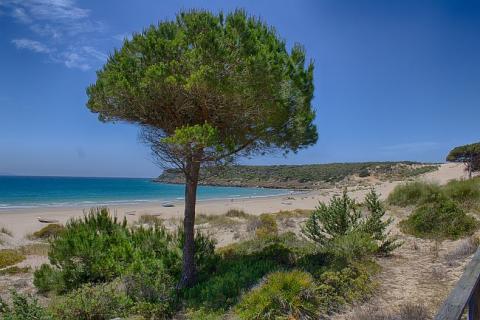Duna de Bolonia is located in the Bolonia beach, some 20km west of Tarifa.
This dune is over 30 metres high and 200 metres wide, and stands out within the huge system of dunes to which it belongs. Located in the Bolonia Inlet, within the Estrecho Nature Park, this is one of the most unspoilt areas of the Cádiz coast, a vital natural habitat with stunning scenery.

Duna de Bolonia
The area is called "barjanal" on account of its half-moon-shaped dunes set perpendicular to the wind, with uneven slopes. It is one of the few transgressive systems in Andalusia, i.e., which are still advancing inland. Under the force of the easterly wind, it moves towards the ecologically important replanted groves of stone pine and scrub.

Wild cactus at Bolonia beach
Although some of Bolonia's sands are covered by exotic species to avoid them advancing further, the cliffs which are battered by the easterly wind have unusual vegetation such as Andalusian coastal juniper, Savin juniper and Portuguese crowberry. In more exposed areas, only Marram grass, sand couch and lotus grow.

Wooden footbridge
There is another line of dunes further back from the beach. Although it is in its infancy, it is coloured by marine thistles, white lilies and sea stock which grow in areas more sheltered from the wind, alongside rushes.

Duna de Bolonia
From the Bolonia-Faro Camarinal Trail you can see the broad beach of fine, golden sand. It is unspoilt and popular with surfers. You can also see the lighthouse with its giants' kettles and the Baelo Claudia archaeological site. This Roman town-factory is in surprisingly good condition and has the National Historic Monument designation.
Also recommended is scuba diving at nearby sites, with outstanding underwater karst formations.
